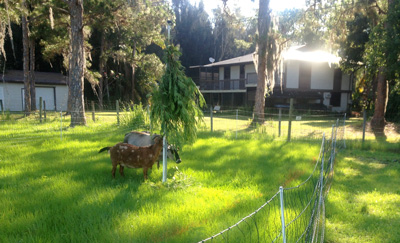On The ECHO Global Farm: Grazing Management Systems
ตีพิมพ์แล้ว
2015-02-23
ECHO's recent activity to integrate livestock more effectively includes revamping the farm's pastures and grazing approach. While for many years ECHO has demonstrated cut-and-carry forage feeding systems for goats, in early 2014 our interns and staff identified goals for minimizing the labor needed to feed the animals while increasing the carrying capacity of grazing animals on the farm's pastures. Focusing on the health of the grass and soil, an intensive rotational grazing management approach that mimics the way large herds of wild animals graze grasslands in nature was selected for implementation. Having reoriented and electrified ECHO's pasture fencing, the new system was operational in July 2014, allowing grazing animals to enjoy the lush, rampant growth of summer grass as they were rotated every other day from one small paddock to another. As a result, intern labor was reduced by one third and the pasture responded favorably to the rhythm of rest, intensive grazing, and recovery.
ECHO is excited to showcase this system with the potential of restoring healthy grasslands and feeding people around the world. Though the situation and approach at the ECHO farm may differ greatly from that of pastoralists in East Africa, resilient and resourceful farmers worldwide can build strategies best suited for their contexts by using guiding principles for sound grazing management. The Savory Institute, based in Boulder, Colorado, advocates a similar livestock grazing approach to help restore grassland health and productivity. With the presence of Savory Institute staff at ECHO's upcoming International Agriculture Conference (November 17-20, 2015), missionaries and development workers will see a tangible example of land management principles and practices on the ECHO farm that can heal the land and positively impact small-scale farmers and their herds worldwide.